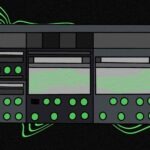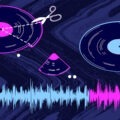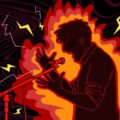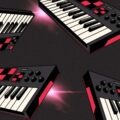Whether you’re a sound engineer or musician, it’s very important to consider the journey that a production goes through from start to finish before hitting record. Oftentimes, it’s counterproductive to treat your tracking, mixing, and mastering sessions as completely separate steps in the process. Let’s check out some common mistakes that people make during the recording stage and how to remedy them to make the entire process easier.
Mistake: Settling for less
It cannot be stressed enough how important it is to make executive decisions while tracking. If you think it could sound better, it’s best to stop recording and set things up so the sound source is being captured properly. It’s true that we have many post-processing tools in the modern age that can help make a poor recording sound better during a mixing session. But it’s also true that these same tools can make a good recording sound great if the recording engineer is diligent.
If you find yourself saying “they can fix it in the mix”, get comfortable with starting over to get things right and to make the life of the mixing engineer easier.
Mistake: Focusing on one instrument
The other common mistake that comes up during a recording session is when the engineer and artist are concentrating too much on a single instrument rather than thinking of how all the elements of the song fit together.
Taking the time to work out which instruments are playing in particular octave ranges, carefully choosing chord voicings, and using wildly different-sounding instruments will help piece things together before you ever reach the mixing stage.
Consider how dark, midrange, or bright your mic placement is for each instrument and don’t be afraid to use a bit of EQ to help nudge things around while placing these mics. Yes, it’s the mixing engineer’s job to make sure everything fits together, but they will have a much easier time doing this when productions are arranged properly.
Mistake: Depth without effects
Don’t wait until the mixing phase to decide which instruments you want to feature up front and which you want to sound further away in the production. Commit to the aesthetic of depth while you’re tracking the instruments, and incorporate the placement of your microphones to reflect this choice. Get the microphone within a few inches of the vocalist’s mouth – or get a microphone grill right into the cone of an amp – if you want these sounds to be very close-sounding. Pull microphones several inches away when you want the instruments to seem further back. Don’t be afraid to try moving the microphones several feet back if needed.
You’re not considering the big picture if you find yourself saying “We’ll put some reverb or delay on it later”.
Mistake: Forgetting width
Stereo width should also be considered during the tracking stage. Consider how wide you want things to be before mixing, instead of just relying on the mixing engineer to pan things around and use stereo exciters. Use stereo microphone techniques when you want to capture the size of the space that you’re recording in.
An example of this could be when recording electric guitars (editor’s note: the author of this article had this problem when doing the instruments for a psychedelic rock band called ‘Gypsy Fist’). The team found it quite difficult to fit the guitar tracks into perspective with reverb or delay during the mix. They ended up re-recording the guitars in a larger room and placing the microphone back 3 feet or more to capture the depth naturally. Some takes were also recorded with stereo microphone positions instead of panning tracks in the mix. The amp was placed to the left, and the open room sound was kept on the right of the stereo placement.
We suggest that you double track performances using different microphones, preamps, and instruments for each take if you need to. These differences make them sound wider when the mixing engineer pans them. If you know you want a wide vocal sound, you can record the singer 3 times. The mix engineer can then leave the best take up the center and pan the other 2 out to the sides.
Mistake: Not planning overall tone
Work closely with the artist and determine what type of spectral balance they would like before you hit record.
Are you going for an overall bright sound? Perhaps they prefer a darker, warmer sound. Do they want certain instruments to be bright and standing out from the rest?
These are important questions to ask during the recording phase because the engineer can subsequently choose certain microphones and angles to reflect this aesthetic.
Ribbon microphones will shade sounds darker right from the recording phase, while FET condensers will make things brighter. Angling a microphone off-axis will change the tone of the recording compared to placing them on-axis, for example.
Want that acoustic guitar to sound more percussive? Mic it that way.
Talk with the artist and get a sense of the kind music they listen to. Many times artists like to mirror certain styles. Knowing what genres inspire their work before getting into the session can help guide the production process/outcome.
Mistake: Effects & source together
It’s quite common to experiment with effects and alternate tones while tracking a song. Sometimes the magic of the moment inspires an amazing delay sound, or perhaps a certain amp in the room just really has a distortion like no one has heard up until that point. It’s important to keep these experiments available to the mixing engineer, but keep them separate from the original source sounds.
Keep DI signals coming straight from instruments on a separate track. Record the amp once without the effects added, and then re-amp them later with the desired effects. If you come up with an awesome plugin-based effect while experimenting, be sure to print it to a separate channel before sending the session off to the mix engineer.
—Final notes—
As an engineer, you want to get into the habit of thinking ahead at every stage of the project. The more the producers plan out aesthetics with the artist before getting to the studio, the closer they will get to capturing what is floating around in the creative minds of the team. The more the tracking engineer considers how to make the mixing process fun and intuitive, the more the energy of the performance will come through the speakers for the listener to enjoy. The more the mixing engineer concentrates on the multitracks instead of the stereo buss, the more effective the mastering engineer can be with their final touches.
Illustration by Yihong Guo






















